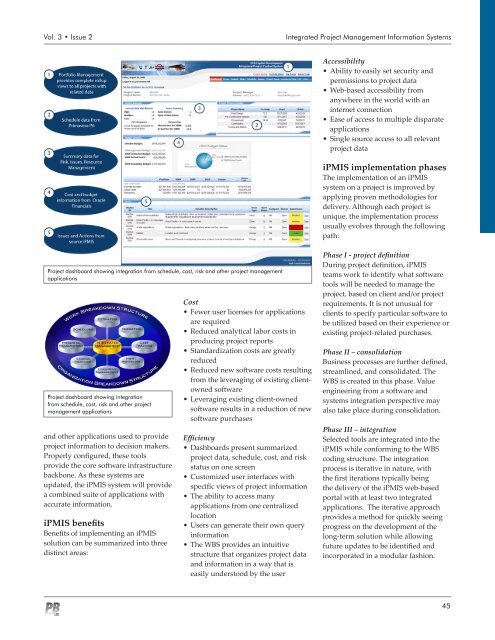ECONOMIC FORECASTING REVIEW - Parsons Brinckerhoff
ECONOMIC FORECASTING REVIEW - Parsons Brinckerhoff
ECONOMIC FORECASTING REVIEW - Parsons Brinckerhoff
You also want an ePaper? Increase the reach of your titles
YUMPU automatically turns print PDFs into web optimized ePapers that Google loves.
Vol. 3 • Issue 2<br />
Integrated Project Management Information Systems<br />
Accessibility<br />
• Ability to easily set security and<br />
permissions to project data<br />
• Web-based accessibility from<br />
anywhere in the world with an<br />
internet connection<br />
• Ease of access to multiple disparate<br />
applications<br />
• Single source access to all relevant<br />
project data<br />
iPMIS implementation phases<br />
The implementation of an iPMIS<br />
system on a project is improved by<br />
applying proven methodologies for<br />
delivery. Although each project is<br />
unique, the implementation process<br />
usually evolves through the following<br />
path:<br />
Project dashboard showing integration from schedule, cost, risk and other project management<br />
applications<br />
Project dashboard showing integration<br />
from schedule, cost, risk and other project<br />
management applications<br />
and other applications used to provide<br />
project information to decision makers.<br />
Properly configured, these tools<br />
provide the core software infrastructure<br />
backbone. As these systems are<br />
updated, the iPMIS system will provide<br />
a combined suite of applications with<br />
accurate information.<br />
iPMIS benefits<br />
Benefits of implementing an iPMIS<br />
solution can be summarized into three<br />
distinct areas:<br />
Cost<br />
• Fewer user licenses for applications<br />
are required<br />
• Reduced analytical labor costs in<br />
producing project reports<br />
• Standardization costs are greatly<br />
reduced<br />
• Reduced new software costs resulting<br />
from the leveraging of existing clientowned<br />
software<br />
• Leveraging existing client-owned<br />
software results in a reduction of new<br />
software purchases<br />
Efficiency<br />
• Dashboards present summarized<br />
project data, schedule, cost, and risk<br />
status on one screen<br />
• Customized user interfaces with<br />
specific views of project information<br />
• The ability to access many<br />
applications from one centralized<br />
location<br />
• Users can generate their own query<br />
information<br />
• The WBS provides an intuitive<br />
structure that organizes project data<br />
and information in a way that is<br />
easily understood by the user<br />
Phase I - project definition<br />
During project definition, iPMIS<br />
teams work to identify what software<br />
tools will be needed to manage the<br />
project, based on client and/or project<br />
requirements. It is not unusual for<br />
clients to specify particular software to<br />
be utilized based on their experience or<br />
existing project-related purchases.<br />
Phase II – consolidation<br />
Business processes are further defined,<br />
streamlined, and consolidated. The<br />
WBS is created in this phase. Value<br />
engineering from a software and<br />
systems integration perspective may<br />
also take place during consolidation.<br />
Phase III – integration<br />
Selected tools are integrated into the<br />
iPMIS while conforming to the WBS<br />
coding structure. The integration<br />
process is iterative in nature, with<br />
the first iterations typically being<br />
the delivery of the iPMIS web-based<br />
portal with at least two integrated<br />
applications. The iterative approach<br />
provides a method for quickly seeing<br />
progress on the development of the<br />
long-term solution while allowing<br />
future updates to be identified and<br />
incorporated in a modular fashion.<br />
45
















